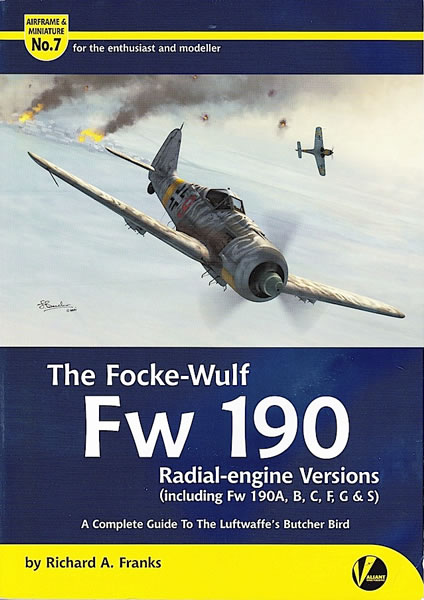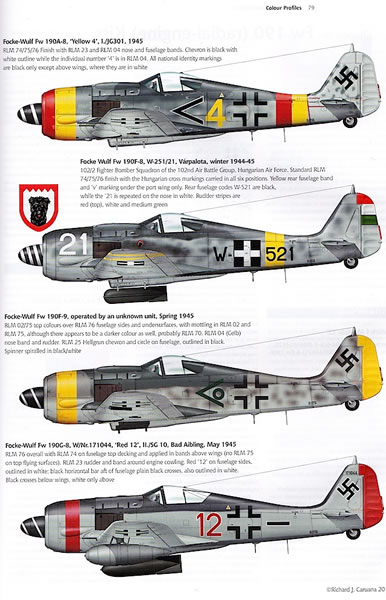The Focke-Wulf Fw 190
Radial-Engine Versions (including the Fw 190A, B, C, F, G and S) – A Complete Guide to the Luftwaffe’s Butcher Bird
by Richard A. Franks

Valiant Wings Publishing
Airframe and Miniature No.7
S u m m a r y |
| Publisher and Title: |
Valiant Wings Publications – Airframe and Miniature No.7: The Focke-Wulf Fw 190 Radial-engine versions (including the Fw 190A, B, C, F, G and S) – A complete Guide to the Luftwaffe’s Butcher Bird |
| ISBN: |
978-0-9575866-4-2 |
| Media: |
Soft-cover A4 format; 224 pages; black and white and colour drawings and photographs; 16 fold-out pages of line drawings, black and white photos and 1/48 scale plans |
| Price: |
£18.95 plus postage available online from Valiant Wings |
| Review Type: |
First Read |
| Advantages: |
A large amount of information is packaged and presented in an interesting, easy to read format. |
| Disadvantages: |
|
| Conclusion: |
This is another commendable effort from Franks and the team at Valiant Wings that usefully complements the earlier Airframe and Miniature book on the Fw 190 D and Ta 152 H. Highly recommended to anyone contemplating a radial-engined Fw 190 kit build, regardless of the scale. |
Reviewed by Brad Fallen

HyperScale is proudly supported by Squadron.com
Richard A. Franks’ seventh Valiant Wings Airframe and Miniature book covers all radial-engined versions of the Focke-Wulf Fw 190.
This is an ambitious undertaking and the resulting volume, at 224 pages, is the biggest in the series to date. Franks has assembled a vast amount of information that he presents clearly and in a logical sequence.
The book is aimed squarely at m
odellers, but will be of interest to anyone who wants to understand the evolution of this superb aircraft. While not everyone will agree with all of Franks’ conclusions, the result is an important compendium of Fw 190 research that is unlikely to be surpassed for some time.
Like all Airframe and Miniature books this is not an operational history, and does not discuss the Fw 190’s contribution to German military efforts in World War 2. Rather, as the series title suggests, the focus is on technical aspects of airframe development and how to replicate the Fw 190 in model form. Franks sets this tone from the beginning, with a six-page preface summarising Würger evolution from the RLM’s 1937 design request to today’s HS-7-powered replicas.
The next four chapters examine this development in detail:
- Evolution – Prototypes and A-Series – most Fw 190s built were A-series aircraft, and this chapter shows the enormous amount of research and development undertaken by Kurt Tank and his team in support of this production. The troubled early prototypes are covered, followed by the A-0, later V-series, A-1, A-2, A-3, A-4, A-5, A-6, A-7, A-8 and A-9. This list sounds perfunctory but Franks’ analysis is anything but, running to over 30 pages and supported by 135 grey scale profiles illustrating the differences between subtypes. There are also a number of black-and-white period photos of selected airframes, which are useful but not always clearly labeled.
- The F and G-series – these close-support and long-range Fw 190s are given the same thorough treatment as the A-series, although the smaller numbers produced means that only 48 profiles are required to cover all variants.
- Conversions, Projects and New-builds – the 16 subtypes described and profiled in this chapter include the two-seat S-series trainers, the B, C and E-series prototypes, and the new build Flug-Werk Fw 190 A-8/N replicas (of which 17 had been produced at the time of publication).
- Camouflage and Markings – Franks begins this chapter by acknowledging that many aspects of World War 2 Luftwaffe camouflage remain open to debate; he then breaks the topic down into logical, easily understood chunks. Themes addressed include Eastern Front and winter operations, Mediterranean theatre, national insignia, operational markings and captured and foreign-operated aircraft. There are helpful black-and-white illustrations of national and squadron markings, while cowl, exhaust, RVD, and theatre markings are shown in full colour. There are also 24 full colour, port view profiles showing a selection of camouflage and markings from the Fw 190 A-2 to the Fw 190 G-8.
Having set the scene Franks devotes the next four chapters to modelling the Fw 190. Again the treatment is thorough, starting with an analysis of radial-engine Fw 190 kits in 1/144, 1/72, 1/48, 1/32 and 1/24 scales. The accuracy of each kit is assessed against criteria including wings, wheel wells, undercarriage, fuselage, tailplanes, engine, propeller, interior, canopy and decals, before a final overall verdict is delivered.

The next three chapters are as follows:
- Building a Selection: Libor Jekl builds four 1/72 kits, Dani Zamarbide builds two 1/48 kits, and Steve A. Evans builds one 1/48 and one 1/32 kits. As one would expect from these modellers, the kits are built to a high standard with text and photos that complement each other well; a verdict is also offered on the quality and buildability of the kit in question.
- Building a collection: this chapter reprises much of the information in the book’s first three chapters, but in a very modeller-friendly format: Franks uses 84 quarter-view drawings to point out the relevant features of each type and sub-type. I’ve found the equivalent chapters in earlier Airframe and Miniature books to be helpful in identifying aircraft from contemporary photographs, and as a quick reference to ensure I’m incorporating the correct features in my models.
- In Detail: this chapter is a walk around that uses wartime photographs and drawings along with modern photos of preserved and restored airframes to build up a complete picture of the Fw 190’s anatomy. Specific areas addressed include cockpit and canopy; fuselage; engine, cowling and propeller; wings; tail; undercarriage and wheel wells; armament, racks and drop tanks; and radio, electrical and camera equipment.
The book concludes with a two- page bibliography of sources, and two eight-page foldouts pasted inside the back cover. The first is a set of 1/48 plans and cross-sections of selected radial-engined Fw 190s; the second contains more plans but also detailed parts diagrams and (usefully for diorama builders) a guide to fitting engine protection covers.
This is another commendable effort from Franks and the team at Valiant Wings that usefully complements the earlier Airframe and Miniature book on the Fw 190 D and Ta 152 H.
Highly recommended to anyone contemplating a radial-engined Fw 190 kit build, regardless of the scale.
Thanks to Valiant Wings Publishing for the sample.
Review Copyright © 2014 by Brad Fallen
This Page Created on 29 December, 2014
Last updated
29 December, 2014
Back to HyperScale Main Page
Back to Reviews Page

|
